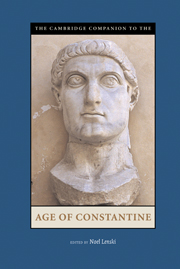Book contents
- Frontmatter
- Introduction
- 1 Sources for the History of Constantine
- Section 1 Politics and Personalities
- Section II Religion and Spiritual Life
- Section III Law and Society
- Section IV Art and Culture
- Section V Empire and Beyond
- 14 Warfare and the Military
- 15 Constantine and the Northern Barbarians
- 16 Constantine and the Peoples of the Eastern Frontier
- Appendix 1: Stemmata
- Appendix 2: Timeline
- Maps
- Primary Sources and Translations
- Secondary Bibliography
- Index
15 - Constantine and the Northern Barbarians
from Section V - Empire and Beyond
Published online by Cambridge University Press: 28 September 2007
- Frontmatter
- Introduction
- 1 Sources for the History of Constantine
- Section 1 Politics and Personalities
- Section II Religion and Spiritual Life
- Section III Law and Society
- Section IV Art and Culture
- Section V Empire and Beyond
- 14 Warfare and the Military
- 15 Constantine and the Northern Barbarians
- 16 Constantine and the Peoples of the Eastern Frontier
- Appendix 1: Stemmata
- Appendix 2: Timeline
- Maps
- Primary Sources and Translations
- Secondary Bibliography
- Index
Summary
Rome’s northern frontiers, running the length of the Rhine and Danube rivers from the North Sea to the Black Sea, faced outwards towards a world filled with peoples not subject to Roman government. In the century that separated the reign of Gallienus from the reign of Julian, we hear of more than a dozen barbarian groups along the Rhine-Danube line: Iuthungi, Franci, Alamanni, Iazyges, Vandali, Carpi, Sarmatians, Goths, Tervingi, Taifali, and so on. Collectively we may refer to them as “barbarians,” a term of art that, despite its pejorative connotation in Greek, Latin, and English, has the signal advantage of making no assumptions about ethnicity. This is important, because the nature of barbarian ethnicity is nowadays a matter of considerable controversy, and the relationship of different barbarian groups to one another is often unclear. The one thing that unites third- and fourth-century barbarians, both as an object of study and as a historical phenomenon, is their collective designation in the sources by the Graeco-Roman idea of the barbarian - the uncivilized “other” outside the borders of the civil world of the empire, the externae gentes (external peoples), who were to be subdued and turned from savagery to gentleness, or harried from imperial territory like wild beasts.
- Type
- Chapter
- Information
- The Cambridge Companion to the Age of Constantine , pp. 347 - 376Publisher: Cambridge University PressPrint publication year: 2005
- 2
- Cited by

